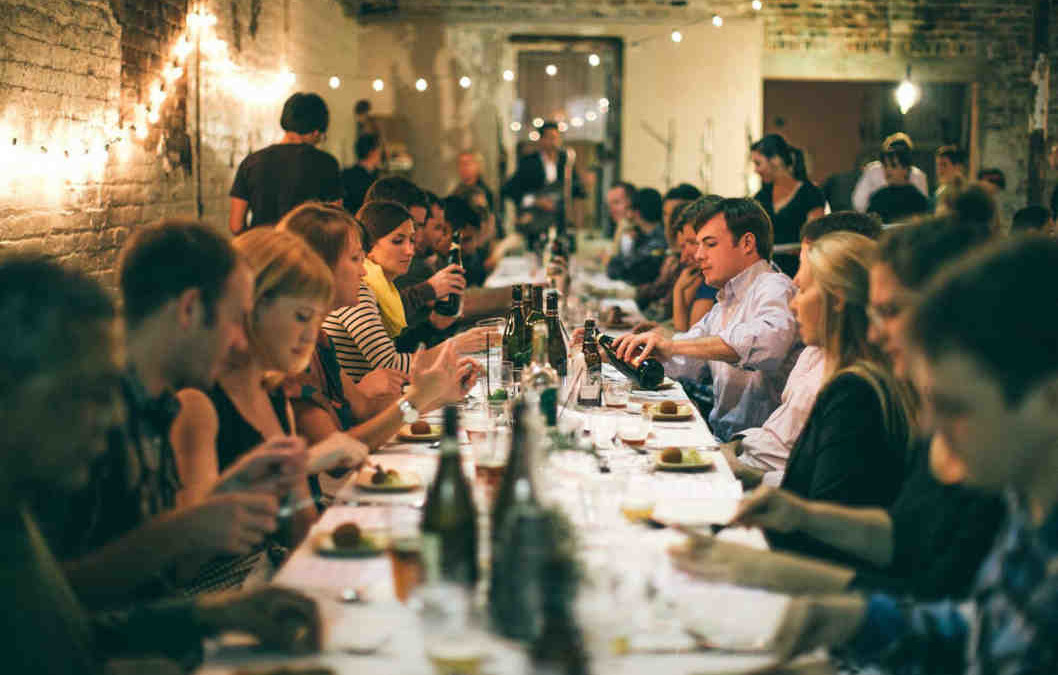Pop up dinners – the name may sound familiar, but the concept isn’t. For ages, restaurants have been providing hungry patrons with food, drink, and ambiance in exchange for a few bucks. Pop up dinners are no different, so long as you shrink the scale of a restaurant and think of it more like an intimate dinner party that you pay to attend.
What are Pop Up Dinners?
Pop up dinners started gaining in popularity in the early 2000s across the U.S., Europe, and Australia in larger metropolitan cities like London, New York, and Sydney. The premise is that up-and-coming chefs who don’t have the financial backing or resources to have their food noticed can collaborate on a pop up dinner where diners pay for a pre fixe meal. These dinners usually happen in smaller event spaces (like a bar or coffee shop), under-utilized restaurant space, and even people’s homes.
How do diners find out about the meals? There are a few ways that pop up dinners gain traction. The most popular channel for spreading the word is unsurprisingly social media, which lets dinner organizers or chefs reach out to potential diners. And because of the increase in popularity, sites like MealTango have started to crop up, which act as a sort of listing site for pop up dinners. More recently, in a more surprising move, Airbnb announced it’s rolling out a pilot program that lets travelers book a meal in a user’s home.
The Benefits of Pop Up Dinners in Lieu of Restaurants
Pop up dinners are kind of fascinating because they turn the traditional idea of a restaurant on its head, blurring the lines between dining out and dinner party. And as with any type of innovation, the whole trend is driven by filling a very specific need in the restaurant industry.
Chefs – especially up-and-coming and amateur chefs – don’t have a whole lot of opportunities for showcasing their work. They might luck out at the restaurant they work at, getting their big break, but those opportunities can be few and far between. Pop up dinners offer these chefs the opportunity to cook for a group of paying customers, without the massive amount of capital needed to open their own restaurant.
But burgeoning chefs aren’t the only ones who can benefit from pop up restaurants. Established chefs – even ones who own their own restaurant – can use them as a launching point for testing out new recipes, cooking styles, and even types of cuisines. Doing this in a restaurant setting can be expensive and risky – they run the risk of turning off their regular clientele if they change the menu too much.
Finally, the diners also benefit from pop up establishments. Trying new restaurants or booking a table at the new “it” restaurant can be difficult and expensive. Setups like this can give diners the opportunity to try new cuisine at much more affordable price points than they’d get at a restaurant. Even more, it introduces people to new styles of cooking, new food pairings, and innovation in the culinary arts. It’s a win/win/win.
The Hidden Pitfalls of Pop Up Dinners
But is it all good news? It’s undeniable that pop up dinners can offer a lot of benefits to both chefs and diners alike. But that’s not the be all and end all. In fact, there are a lot of potential issues and hazards that could lead to the downfall of pop up dinners – and they mostly revolve around regulation.
There’s a reason that restaurants are expensive and time consuming to open. Feeding the public can have pretty massive consequences if it isn’t done correctly. From food safety regulations to building code requirements, there are a number of regulations in place to help keep diners safe when they’re eating out. When you go to a mid-tier or nice restaurant, you can pretty much guarantee that the kitchen is clean, the food is fresh, and that there are well documented processes for getting out in case of an emergency. Those same regulations that govern restaurants don’t do the same for pop up dinners. Because the entire point of a pop up dinner is that it’s an underground event, you could be eating with 50 people in a space that’s designed for 20, which is a fire hazard. The chef could be cooking on outdated appliances or failing to use proper food safety measures.
And then there’s the potential environmental impact. Because commercial kitchens must be equipped with devices that ensure the proper disposal of food products and byproducts, chefs who host pop up dinners could be allowing grease to get into wastewater treatment centers.
Is there a happy medium? I like to think so. There’s no reason why pop up dinners can’t operate from a position where they meet all food safety rules and regulations, while still holding on to the grittiness and cool factor of being this underground food trend. In fact, there are some pop up dinners that already do this by ensuring that chefs cook food in certified commercial kitchens before allowing the meals to be transported to a pop up dinner event space.
With more and more people looking for an alternative to the traditional restaurant scene, I think we’ll continue to see a rise in pop up dinners. And so long as safety is a top concern, I think it’s a trend that deserves to increase in popularity.
Let us know: have you ever eaten at a pop up dinner? Would you ever eat at a pop up dinner?





